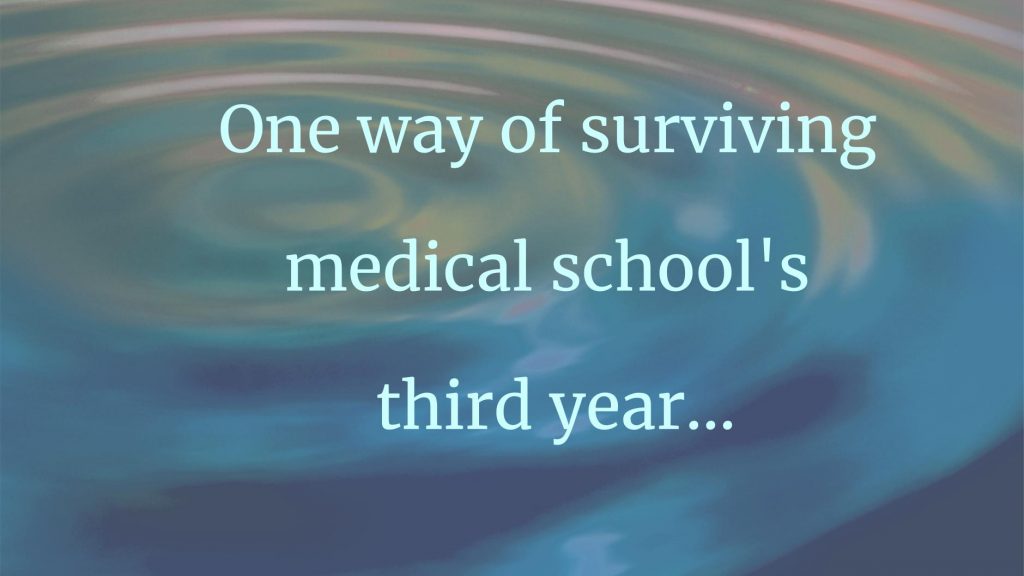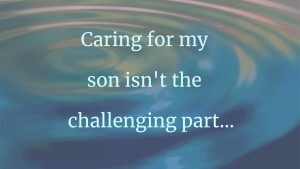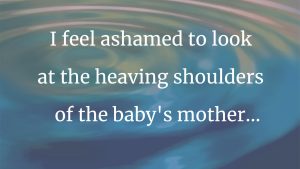Question: What is the most read book in a psychiatric ward?
Answer: Based on my observations, it’s the Christian Bible. During my psychiatry rotation in the third year of medical school, I saw so many patients researching, reading and preaching the word of God. Clearly, in those pages they found something they needed: vengeance against those who’d wronged them, a secret prophecy, confirmation of their sanity. Or maybe they saw the central message: “You’re loved. We (God, humans, nature, whatever) care for you and will take care of you. We understand you.”
Seeing these patients cling to the Bible felt moving and deeply sad–painful, really. A younger, more innocent me might have seen some grace and faith. But, honestly, all I saw was emptiness–in the sense that patients in deep despair, who’ve been told, “Your mind is broken,” “Your body is broken” or “You’re going to die soon,” lack something in their lives: real human connection.
My third-year rotations have taught me that interacting day after day with people in pain does one of three things to you. The first two are (1) burn you out and (2) shut you down. I believe that these things unfold slowly; we don’t see them until it’s too late. That’s why our teachers and mentors have blasted “balance” and “mindfulness” into us. They know. They’re warning us about a coming storm.
I’ve suffered from this storm’s effects over the last year. I have felt myself detaching and growing numb to my patients. I think of the pregnant heroin addict who was vomiting on my arm and wouldn’t sit still for a CT scan. Really, all I wanted was for her to shut up and stop jerking us around; I found myself ignoring her complaints of being too nauseated to lie flat. Feeling angry, I retreated when maybe I should have tried to comfort her instead.
I’ve also started to retreat into myself. I’ve thrown more and more energy into cheap thrills that get me out of my head for a minute. The more time I spend watching patients in pain, the more I need to numb myself by binge-watching Netflix or mindlessly surfing the Web.
On the other hand, I’ve also found the third option: I can be uplifted. Making that happen takes a lot of work, but at the same time, it offers something spiritual.
Recently, on a slow day, I talked about this with a surgeon.
“Based on my personal experience, I’d never recommend medicine to anyone,” he said. “I’m tired and lonely at the end of the day. I’m single, and I don’t have enough free time to meet anyone outside of work. My health is suffering, and I feel like a pawn being moved around by hospital administration.”
“So what keeps you coming back to work every day?” I asked.
He thought for a moment. “There’s something about helping people in need–not just helping them to get rich, or selling them something, but really helping them–that makes it all worth it.”
His words affirmed my growing sense that, in order to have a fulfilling life in medicine, you not only need to create balance and wellness for yourself; you also need to embrace connections with people during your work day.
Last week, I had a chance to test this hypothesis.
In the ICU, I helped care for a lady named Rita who’d had a very complex surgery, with multiple complications. A few days after the surgery, she was improving, but was still on a breathing tube. She was so swollen, she looked like an inflated water balloon, her skin so fragile that I was afraid the pressure from my stethoscope would rip it. During rounds, I noticed her watching, in what seemed like mute terror, as nurses and residents swarmed around her, checking the ventilator settings, recording the IV drips and taking blood.
One morning, after Rita’s physical exam was done, I sat with her and allowed myself to feel her pain. Without thinking, I reached out and held her swollen hand.
She tried to mouth words around the breathing tube, but I couldn’t make them out. Gripping my hand tighter, she silently began to cry. I tried to look calm, peaceful and loving, but I know that some part of my face reflected the horror I felt–not the horror of holding her hand, but of really entering into her experience. It was a living nightmare: unable to talk, trapped in a broken and swelling body, barraged by beeping machines and daily needles and, worst of all, deprived of nearly all human contact.
That night I walked home in a trance, feeling strangely energized and expansive. On my evening run, as I felt my feet pounding the pavement, I also heard the steady beep and whir of Rita’s monitors.
As unpleasant as it was to view the world through Rita’s eyes, I also found something about the experience empowering–and so, I believe, did she. Every morning, I would bounce awake to go check on her and provide my brief daily hand-holding. She would visibly brighten when I came in. While tracking her fluid intake and output like a hawk and ensuring that her wound was healing, I also monitored her well-being and titrated my dose of connectedness accordingly.
Two days after we removed the breathing tube, when Rita could finally talk again, she looked at me and hoarsely murmured, “Thank you.”
Her eyes shone with a peace and joy that is hard to describe. It made me feel like crying, dancing and laughing, all at the same time; I felt a deep sense of connection. It was like gazing into the eyes of God.
Since then, I’ve tried to keep moments like these at the forefront of my mind. Doing so has taught me a few things.
I’ve learned that I’m human. Really, painfully human. I’m afraid of the things most people are afraid of: pain, suffering, loneliness and loss. I’ve learned that if I’m exposed to those things without taking time to reflect on them, I will burn out and shut down. But I’ve also learned ways to ease their toll on me.
I’m working at building up a supportive network of family and friends by sharing my feelings and experiences with the people closest to me. I’m looking for opportunities to use my knowledge and compassion to give relief and respite to suffering patients. And, most importantly, as I did with Rita, I’ve started entering into their experiences in order to connect with them more fully.
I’m really glad that so many patients find comfort in the Bible. But I hope that some will also take comfort in my presence and in my willingness to be there with them when life is hard.
As I’m starting to realize, our connection to each other just might be the greatest gift medicine has to offer–to me, and to all of us.
About the author:
Matthew Baer is a fourth-year medical student at Creighton University School of Medicine Phoenix Regional Campus. These past few months, he’s been applying to family-medicine residency programs and interviewing around the country. In his free time, he enjoys hiking in the mountains near Phoenix, training for the next marathon or rock climbing at the local gym. “Going to medical school has made me more aware of the need to slow down and process my experiences. I started journaling during my first year of medical school, then, in my third year, began to focus on the things (power dynamics, death and dying, burnout) I saw during clinical rotations. This piece began as one of those journal entries.”









9 thoughts on “Being There”
I just love this. How marvelous that embracing and sharing pain actually makes things better. Trying not to feel is a sorry error. As Haim Ginott said, Fish swim, birds fly, and people feel. So glad you are a sometimes hurting, always-connected full human being.
It is quite amazing that you managed to learn this so early in your career.
I often wondered how much distance we really need between us and the patient. It is lovely that you found your answer and that she woke up to confirm how right you were.
This piece is hugely powerful – thank you. I am editing a book for Leicester Medical Students in the UK – New perspectives in compassion – It would be great to have you making a contribution with the chapter-to contact me please email me at rcc16@le.ac.uk – My profile is available by searching under Leicester medical school-Rodger Charlton – thank you
Bravo. Mathew.
As Michael Balint learned, the most frequently used drug (in general practice) is the doctor him/her self.
I am deeply moved, I resonate with this so much. Thank you.
Matthew, Thanks for sharing your experiences. As I read your story about Rita, I was reminded of Matthew 25:36: “I was naked and you clothed me. I was sick and you cared for me. I was in prison and you visited me.” Your presence is one of the greatest gifts you can bestow upon your patients.
Thank you for sharing this wonderful insight. I am a retired public health physician and have recently had to deal with my own worsening health. I can empathize with both you and your patient Rita. I have sought counseling myself and learned that I can still be useful. In the assisted living facility in which I now live, I seek out others who need a listening ear, or a hug when they are sad from losing a loved spouse or hearing bad news about their own health. I also use journaling in the form of poetry on a regular basis and it is quite cathartic. But most of all, by helping others again I have regained my will to live and find joy in these small acts of kindness.
Thanks for your compelling and raw story, Michael. I think you are right on about the connection piece. As an RN w/ many years of practice and now a focus on teaching communication skills, I’ve come to believe that there is a privilege in our work. And that is we play a role in helping people when they are vulnerable. Please take good care of yourself as that is critical to you being there over time.
I’m always so glad to see new doctors learn compassion despite their own difficult path towards becoming a doctor.